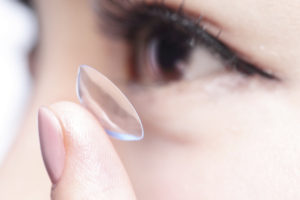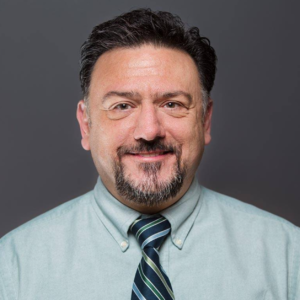sponsored content
January 16, 2023
By Jason Jedlicka, OD, FAAO
We prescribe the majority of our myopia management patients OrthoK lenses, and having this kind of technology allows us to treat a wide variety of patients – from the most complex to the most common.

At the contact lens service at the Indiana University School of Optometry, we offer the full spectrum of contact lenses — contact lenses for refractive error, specialty lenses for irregular corneas, presbyopia, and of course, contact lenses for myopia management. In my role as chief of the service, I have the opportunity to work with other practitioners inside and outside the program and collaborate in the care of many of our patients. We have the ability to change lives with how we prescribe contact lenses for our patients. I have been a believer in the impact of contact lenses and the optics they can present to the developing eye as a way to alter the course of myopia progression for many years. I have been prescribing orthokeratology for nearly 20 years, and probably for the last 12 years, mainly for children to slow myopia progression.
We prescribe OrthoK to the majority of our myopia management patients. It is ideal for those younger myopes, ages 5-12, as the entire process of using lenses happens at home under parental supervision. We don’t have to worry about lost or broken glasses, rubbing a soft lens out of the eye at school, or dealing with lenses in the eye at an inopportune time, such as when swimming at a friend’s house.
Designing OrthoK Lenses
For many years I fitted OrthoK mostly with diagnostic lenses. This was partially due to the fact that most lenses weren’t very customized, and being at a teaching institution, it seemed easier to teach OrthoK from a fitting set. However, as OrthoK has evolved and lenses have more design options available, we are able to increasingly individualize the treatment, including optimizing optic zone sizes for the patient’s Rx and for myopia management. We find that given the option of a more customized design for their child, the parents of most of our children prefer having us use our technology and acquire as much data as possible rather than to order the lens empirically. A topography-based design provides the fitter with the greatest ability to customize the OrthoK lens for the specific eye. Empirical fitting has come a long way — while we used to use just Ks and the Rx, now a good empirical design will require corneal diameter and corneal eccentricity information in both major meridians. We can often get great first fit accuracy, but for this kind of precision, it requires good topographical data. As the old saying goes, “garbage in, garbage out,” and so it is with empirical or software-based lenses utilizing corneal size and shape data.
Our practice has utilized the OCULUS Pentacam tomographer to design OrthoK lenses for the last few years. The most significant benefit I’ve noticed is the increased data coverage of the cornea — you get more true shape data and not just extrapolated data. This allows more accuracy with the lens fit from the map. This accuracy is manifest in the total depth of the lens and how close it sits to the central cornea, as well as the angle of the alignment zone. Regarding software-based designs, there is no comparison to having that full corneal data versus an 8-10 mm area of coverage by the map. The last 2-4 mm of the cornea can have a significant impact on lens design outcomes, and it’s hard to be as precise without it.
Advanced Technology Improves Efficiency
Designing OrthoK lenses with the WAVE Contact Lens System has certainly improved our efficiency. I think the greatest advantage is evident when you have the software design the initial lens for you. In a matter of seconds, you have a lens with the correct base curve, the optic zone diameter you want, accounting for corneal toricity or quadrant specific effect — provided you opt for a freeform lens design. This means that your first lens has a very high likelihood of being dispensable, even with unusual corneal shapes or higher prescriptions, provided the map you obtain is accurate and reliable. This added efficiency equals less chair time, fewer lens reorders, fewer appointments to follow up the lens fit, and a lower risk of suboptimal results.
When considering the time it takes to create a new lens using WAVE, from the moment I open the WAVE software to choose the lens design I want, to enter RX data, adjust the OZD, Jessen factor, or other aspects of the lens design I want to customize, to when I choose materials, color, and hit order, it takes less than one minute per lens. This is probably less time than it would take to call in the order by phone — and with better results in most cases.
All aspects of efficiency can be appreciated by all practitioners. The software is very powerful and has much to offer fitters of all levels of experience. New fitters can accelerate their learning of the concepts of OrthoK by visualizing the tear layer under the lens in the software. New fitters can also gain confidence in their fitting outcomes without many of the struggles of trial and error that must be overcome when using diagnostic sets or ordering empirically. Experienced fitters can take on increasingly complex cases and customize their designs with almost no limit. In addition, an experienced fitter can determine their own fit algorithms and save them in the software, creating their own unique, user-specific, and patient-specific designs.
The WAVE Contact Lens System, more than ever with the new user interface and modification tools for making fit adjustments, gives the fitter full power to make precise changes as needed and to know precisely what those changes are in microns. This can be adjustments not only to the fit, such as lens depth or alignment adjustments, but changes to the optic zone diameter in 0.1 mm increments. You can also make fit changes over the entire lens, meridionally or in quadrants. In essence, the WAVE system allows you, as the fitter, to have complete control over changes to the lens in exactly the amounts you need. There is no hidden formula, just pure control over parameters.
We prescribe the majority of our myopia management patients OrthoK lenses, and having this kind of technology allows us to treat a wide variety of patients – from the most complex to the most common. Whether the prescription is on the higher end, there is substantial corneal toricity, or the cornea has a flatter or steeper shape, I feel confident in prescribing OrthoK lenses for nearly any patient that comes into my exam room.
 |
Dr. Jedlicka is a Professor at the Indiana University School of Optometry and the Director of the Cornea and Contact Lens Service. He is a Diplomate in the American Academy of Optometry’s Cornea, Contact Lens, and Refractive Technologies Section, a past President of the Scleral Lens Education Society, and a Fellow and board member of the Contact Lens Society of America. He has contributed to multiple textbooks as an author on the topic of GP lenses. He was awarded the GPLI practitioner of the year award for 2021. He is the developer of the Zenlens family of scleral lenses.
|













